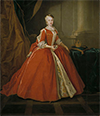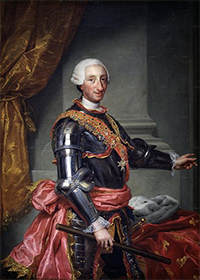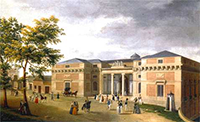King Charles III of Spain
Part 2: Reigning in His Own Right Charles initiated construction of one of Europe's most lavish palaces, the Palace of Caserta. His wife played a large part in this. 
In 1738, Charles had married Maria Amalia of Saxony. The couple had 13 children, seven of whom survived into adulthood:
Charles's half-brother Ferdinand had succeeded their father as king in July 1746. Like Philip, Ferdinand struggled with mental and physical issues. Ferdinand died on Aug. 10, 1759, and Charles became King Charles III. One of his first challenges as reigning monarch was ruling the country in the wake of a great personal grief: his wife, Maria Amalia, died unexpectedly in 1760, when she was just 35. He grieved and did not marry again. 
Building on his experiences in Italy, Charles as King of Spain governed as very much a product of the Enlightenment, a powerful and wide-ranging movement the principles of which fostered ideas of equality and toleration. One action contrary to this was the expulsion of the Jesuits. He had been tolerant of Jews while ruling in Italy but, in 1767, ordered the Jesuits out of both Spain proper and the Spanish overseas colonies. The national government seized the properties that these people, some of whom were were very wealthy and prominent, left behind. As in Italy, he chose his advisers well; standouts were the Count of Arenda and the Count of Floridablanca, who helped him craft a series of reforms that helped oil the engine of progress and innovation. Continuing a process begun his two predecessors, who revoked longstanding privileges of nobles and worked to encourage the idea of a nation-state, Charles oversaw the creation of a national anthem and a national flag. The anthem, Marcha Real, remains one of only four in the world that has no official lyrics. Charles also instituted a flag for the royal navy. The Seven Years War was raging when Charles ascended the throne, but Spain did not enter that conflict until 1762. Spanish efforts were mostly disastrous. An invasion of neighboring Portugal came to nothing. In the New World, Spain lost control of Havana, Cuba, and Manila, the Philippines. The 1763 Treaty of Paris, which ended the Seven Years War, was somewhat favorable to Spain, in that Great Britain agreed to relinquish control of Havana and Manila in exchange for a strip of land on the North American mainland known as West Florida. Most significantly, Britain's victory over France freed up the territory known as Louisiana, which Britain ceded to Spain. Charles's navy continued to struggle for supremacy in the New World, coming to blows with Great Britain and Portugal at various times during the next two decades. Spain also got involved in the American Revolutionary War, opposing the British by siding with the Americans. Spanish forces retook West Florida during the war and East Florida during peace talks that ended the war. 
While all of that warfare was occurring overseas, Charles's efforts at reform at home were bearing fruit. His support for a reformed education system extended to patronage of scientific research at institutes of higher learning. A new series of roads and canals led to Madrid, emphasizing that city as the true capital of the true nation state. As had Philip V before him, Charles reworked the revenue system, in party by eliminating a hugely unpopular tax on flour. The cotton trade greatly improved, as did overseas trade. He also created the National Lottery, which became a largely popular revenue generation scheme. In the area of construction, he oversaw the construction of two large museums, the Museo del Prado (right) and the National Art Museum of Queen Sofia, and some significant additions to the Royal Palace. It was at the Royal Place that Charles died, on Dec. 14, 1788. Succeeding him was his oldest son, also named Charles. Thus began the reign of King Charles IV. First page > A King in Waiting > Page 1, 2 |
|
Social Studies for Kids
copyright 2002–2025
David White




